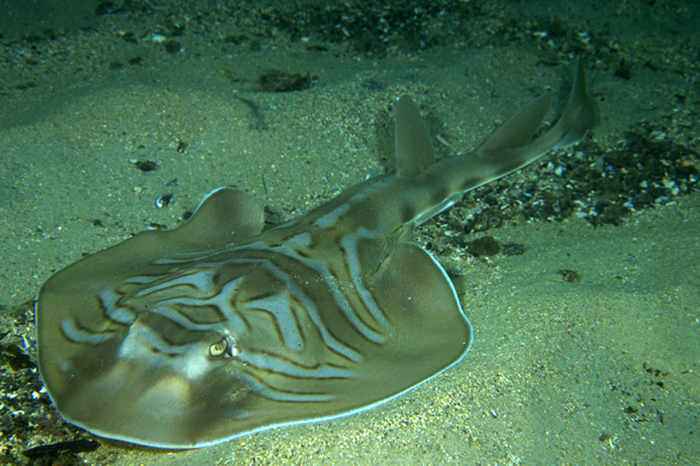Eastern Fiddler Ray, Trygonorrhina fasciata Müller & Henle 1841

Eastern Fiddler Ray, Trygonorrhina fasciata. Source: Rudie H. Kuiter / Aquatic Photographics. License: All rights reserved
Video of A male Eastern Fiddler Ray, Trygonorrhina fasciata, at Shark Point, Sydney.
Video of an Eastern Fiddler Ray at Bawley Point, New South Wales.
Eastern Fiddler Ray, Trygonorrhina fasciata Müller & Henle 1841
More Info
|
Distribution |
Endemic to eastern Australia from southern Queensland, to east of Wilsons Promontory, Victoria. Occurs mostly on inshore sandy areas and on the inner continental shelf in depths to about 100 m. |
|
Features |
Disc suboval, slightly longer than wide; snout short & broadly rounded; ridges of sharp thorn-like denticles on shoulders and midline of disc; tail 1.3-1.4 times longer than disc in adults; dorsal fins large, widely-spaced. |
|
Size |
Grows to about 120 cm TL, although individuals rarely exceed 110 cm. |
|
Colour |
Brownish with or without blotches, and an ornate pattern of lilac bands (with darker margins) including a distinctive triangular or diamond-shaped marking just behind the eyes; underside whitish. |
|
Feeding |
Carnivore - feeds mostly on crabs and shrimps. |
|
Biology |
Fiddler rays have internal fertilisation and are aplacental viviparous (ovoviviparous) - meaning that the embryos develop inside eggs and hatch within the uterus of the mother before birth. Females produce litters of 2-3 pups, which are born at a length of about 25 cm TL. |
|
Fisheries |
Taken as bycatch in commercial trawls, and marketed as guitarfish. |
|
Conservation |
IUCN: Least Concern |
|
Remarks |
|
|
Similar Species |
The similar Southern Fiddler Ray, Trygonorrhina dumerilii, lacks the triangular marking on the head behind the eyes. |
|
Etymology |
The specific name is from the Latin fasciatus (= banded, striped) in reference to the bands on body and tail. |
|
Species Citation |
Trygonorrhina fasciata Müller & Henle 1841, Systematische Beschreibung der Plagiostomen: 124. Type locality: Type locality: New Holland (= Australia) |
|
Author |
Bray, D.J. 2024 |
|
Resources |
Eastern Fiddler Ray, Trygonorrhina fasciata Müller & Henle 1841
References
Donnellan, S.C., Foster, R., Junge, C., Huveneers, C., Rogers, P., Kilian, A. & Bertozzi, T. 2015. Fiddling with the proof: the magpie fiddler ray is a colour pattern variant of the common southern fiddler ray (Rhinobatidae: Trygonorrhina). Zootaxa 3981(3): 367-384, http://dx.doi.org/10.11646/zootaxa.3981.3.3
Grant, E.M. 2002. Guide to Fishes. Redcliffe : EM Grant Pty Ltd 880 pp.
Johnson, J.W. 2010. Fishes of the Moreton Bay Marine Park and adjacent continental shelf waters, Queensland, Australia. pp. 299-353 in Davie, P.J.F. & Phillips, J.A. Proceedings of the Thirteenth International Marine Biological Workshop, The Marine Fauna and Flora of Moreton Bay. Memoirs of the Queensland Museum 54(3)
Kuiter, R.H. 1993. Coastal Fishes of South-eastern Australia. Bathurst : Crawford House Press 437 pp.
Last, P.R. & Séret, B. 2016. 12. Banjo Rays. Family Trygonorrhinidae, pp 117-126; 13. Fanrays. Family Platyrhinidae, pp 127-133 in Last, P.R., White, W.T., Carvalho, M.R. de, Séret, B., Stehmann, M.F.W. & Naylor, G.J.P. (eds) Rays of the World. Clayton South, Victoria : CSIRO Publishing 790 pp.
Last, P.R. & Stevens, J.D. 1994. Sharks and Rays of Australia. Canberra : CSIRO Australia 513 pp. 84 pls (p. 294, as Trygonorrhina sp. A)
Last, P.R. & Stevens, J.D. 2009. Sharks and Rays of Australia. Collingwood : CSIRO Publishing Australia Edn 2, 550 pp.
Macbeth, W.G., Vandenberg, M. & Graham, K.J. 2008. Identifying Sharks and Rays; a Guide for Commercial Fishers. Sydney : New South Wales Department of Primary Industry 71 pp. (p. 66, as Trygonorrhina sp. A)
Marshall, L.J., White, W.T. & Potter, I.C. 2007. Reproductive biology and diet of the southern fiddler ray, Trygonorrhina fasciata (Batoidea: Rhinobatidae), an important trawl bycatch species. Marine and Freshwater Research 58: 104-115
May, J.L. & Maxwell, J.G.H. 1986. Field Guide to Trawl Fish from Temperate Waters of Australia. Hobart : CSIRO Division of Marine Research 492 pp.
Müller, J. & Henle, F.G.J. 1841. Systematische Beschreibung der Plagiostomen. Berlin : Veit & Co. pp. 103-200 pls See ref at BHL
Reis, M. & Figueira, W.F. 2020. Diet and feeding habits of two endemic demersal bycatch elasmobranchs: Trygonorrhina fasciata & Dentiraja australis. Ichthyological Research 67: 320–329, https://doi.org/10.1007/s10228-019-00724-7
Whitley, G.P. 1940. The Fishes of Australia. Part 1. The sharks, rays, devil-fish, and other primitive fishes of Australia and New Zealand. Sydney : Roy. Zool. Soc. N.S.W. 280 pp. 303 figs







